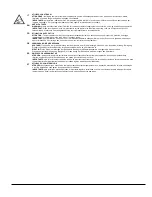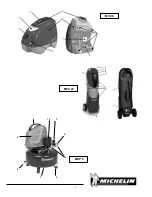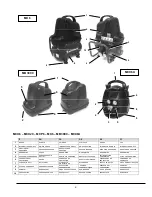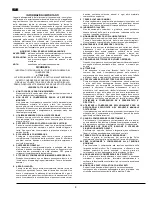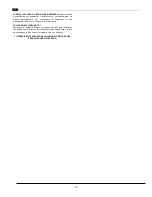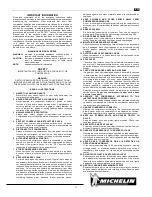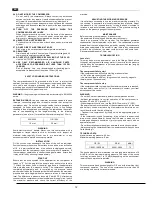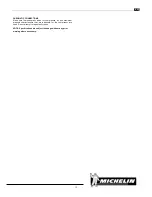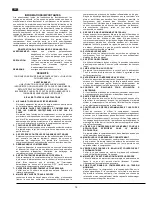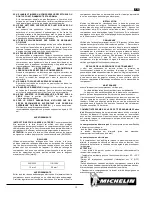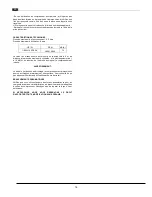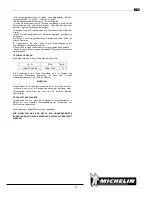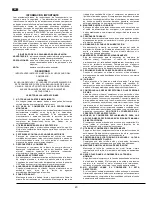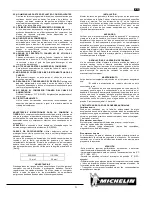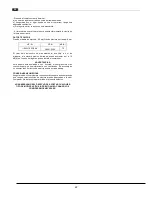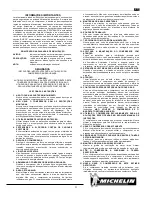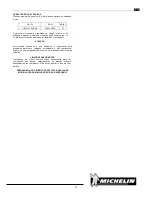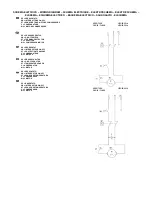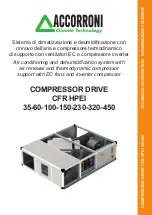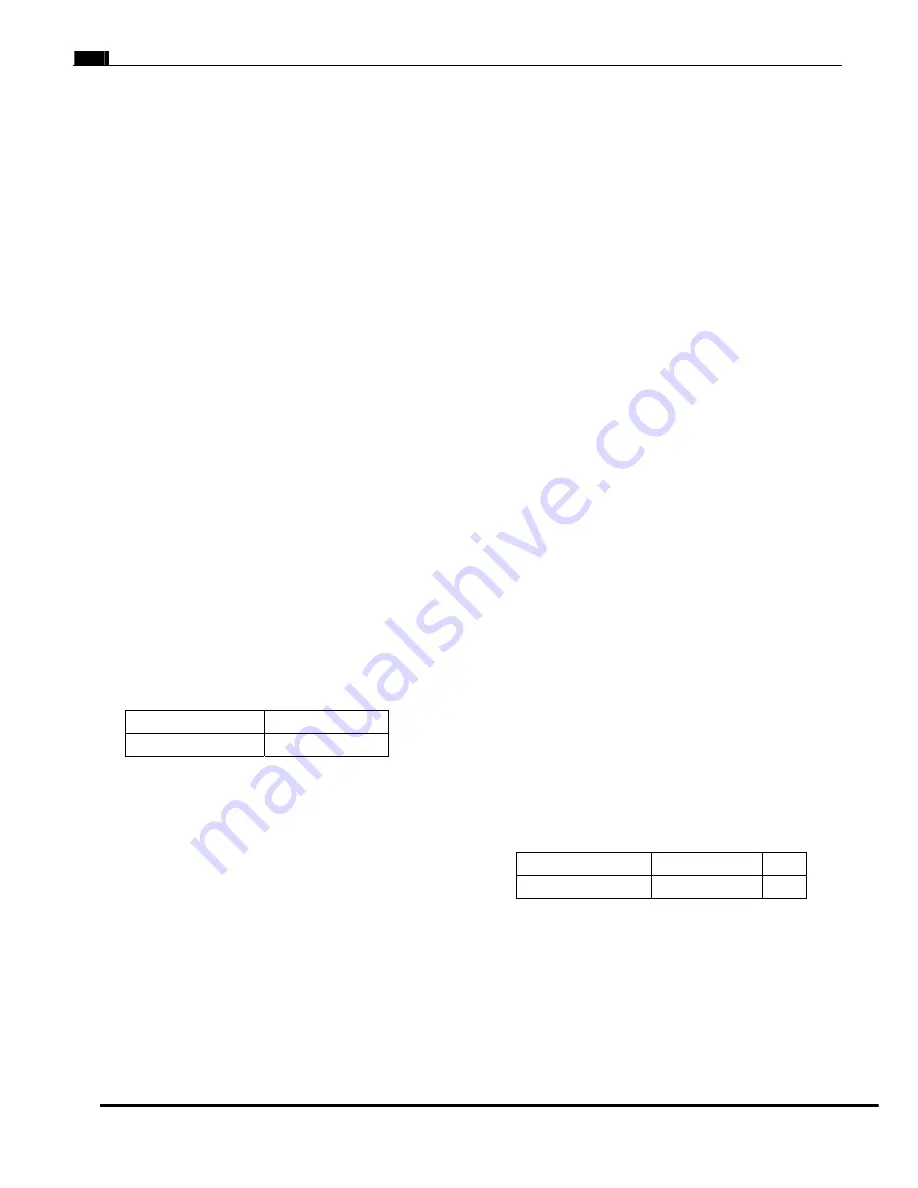
EN
12
24 DO NOT MODIFY THE COMPRESSOR
Do not modify the compressor. Always contact the authorized
service center for any repairs. Unauthorized modification may not
only impair the compressor performance but may also result in
accident or injury to repair personnel who do not have the required
knowledge and technical expertise to perform the repair operations
correctly.
25
TURN OFF THE PRESSURE SWITCH WHEN THE
COMPRESSOR IS NOT IN USE
When the compressor is not used, turn the knob of the pressure
switch OFF, disconnect it from the power source and open the
drain cock to discharge the compressed air from the air tank.
26 NEVER TOUCH HOT SURFACES
To reduce the risk of burns, do not touch tubes, heads, motors and
cylinder.
27 DO NOT DIRECT AIR STREAM AT BODY
Risk of injury, do not direct air stream at persons or animals.
28. DRAIN TANK
Drain tank daily or after 4 hours of use. Open drain fitting and tilt
compressor to empty accumulated water.
29. DO NOT STOP COMPRESSOR BY PULLING OUT THE PLUG
Use the “AUTO/OFF” knob of pressure switch.
30.
USE ONLY RECOMMENDED AIR HANDLING PARTS
ACCEPTABLE FOR PRESSURE NOT LESS THAN 125 PSI
(8.6 BAR)
Risk of bursting. Use only recommended air handling parts
acceptable for pressures not less than 125 psi (8.6 bar).
SAFETY GROUNDING INSTRUCTIONS
The compressor should be grounded while in use to protect the
operator from electric shock. The compressor is equipped with a three-
core cable and three-pin grounding type plug to fit the proper
grounding type socket. Never disassemble the compressor or carry out
other connections to the pressure switch.
WARNING
– the grounding must be carried out according to EN 60204
norms.
EXTENSION CABLE
Use only three-way extension cables that have
three-pin connecting plugs and three-pole sockets that accept the
compressor plug. Do not use extension cables that are damaged or
squashed. An under-rated cable will cause a drop in line voltage
resulting in loss of power and overheating. The table shows the correct
size to use depending on the length according to the following
parameters (size in [mm
2
] for a cable with maximum length of 20 mt.):
220/230V 110/120V
1,5 mm²
2,5 mm²
WARNING
Avoid electrical shock hazard. Never use this compressor with a
damaged or frayed electrical cord or extension cord. Inspect all
electrical cords regularly. Never use in or near water or in any
environment where electric shocks are possible.
INSTALLATION
Fit the suction cups underneath the base of the unit as indicated.
Position the compressor on a flat surface or one with a max. inclination
of 10° in a well-ventilated area. If the surface is sloping and smooth,
make sure that the compressor does not move while in operation. If
the compressor operates on a shelf or the edge of a stand, ensure that
it may not fall off by securing it appropriately.
START-UP
Ensure that the knob situated in the upper part of the compressor is
turned to “0”. Put the plug into the power socket and turn the knob to
“I”. Attach the rubber hose or the spiral type hose to the appropriate
fitting situated near the pressure switch. The compressor operates
completely automatically and is controlled by the pressure switch
which stops it when the pressure inside the tank reaches the maximum
pressure and starts it again when the pressure returns to the minimum
level. The difference in pressure is usually 2 bar (29 PSI). After having
connnected the compressor to the electrical power supply line, load to
the maximum pressure and check the correct efficiency of the
machine.
ADJUSTING THE WORKING PRESSURE
It is not always necessary to use the maximum working pressure. On
the contrary, a pneumatic tool usually requires less pressure. Adjust
the pressure to the required level by turning the knob clockwise to
increase it and anti-clockwise to decrease it. The pressure setting is
shown on the pressure gauge of the compressor.
MAINTENANCE
Before servicing the compressor, make sure that:
-the power cable is unplugged from the electricity supply.
-there is no pressure in the air receiver. The compressor generates
condensation that accumulates in the tank. The condensate must be
drained from the tank at least once a week by opening the condensate
drain valve underneath it. Be careful in case there is any compressed
air within the cylinder as the water could burst out with some force.
Recommended pressure 1-2 bar max.
TROUBLESHOOTING
Loss of air
This may be due to the poor seal of one of the fittings. Check all the
fittings by wetting them with soapy water. It is normal for the pressure
to drop when the compressor is not used, whatever the case (roughly
1 bar every 5 minutes).
The compressor fails to start
If the compressor has difficulty in starting, make sure that:
- all the wires are correctly connected.
- the mains voltage is efficient (plug connected correctly, magneto-
thermal switch, fuses unblown).
The compressor fails to stop
If the compressor fails to stop when the maximum pressure is reached,
the tank safety valve will cut in. It is necessary to contact your local
authorised service centre.
WARNING
-Do not drill, weld or intentionally deform the compressed air tank.
-Ambient temperature for correct operation of the compressor is
between 0°C and 25°C (max.45°C).
-When temporarily not in use, turn the ON/OFF switch to “0” (OFF).
-Be aware that some components of the compressor such as the head
and delivery hoses, may reach high temperatures, therefore do not
touch them to avoid the risk of burning.
- Transport the compressor by lifting it with the appropriate grips or
handles.
-If the compressor is used for painting: a) do not work in an enclosed
area or near naked flame b) ensure that the area in which you are
working has adequate ventilation c) protect nose and mouth with an
appropriate mask
-Do not direct airstream at people or animals to avoid serious injuries.
-Always unplug the compressor from the power socket when you have
finished using it.
TECHNICAL DATA
Maximum running pressure: 8.9 bar.
Maximum working pressure: 8 bar.
HP / W
RPM
dB(A)
1/800-1100 PEAK
2800
÷
3000
72
The sound pressure level measured in a free range at a distance of 4
mt. dB(A) at the maximum working pressure. The value of the sound
level may increase from 1 to 10 dB(A) depending on the environment
in which the compressor is installed.
WARNING
This compressor has been designed for DIY use with intermittent (not
continuous) operation. The use of the compressor for more than 20
min. during one hour is not recommended.
Summary of Contents for MB 3000
Page 2: ......




